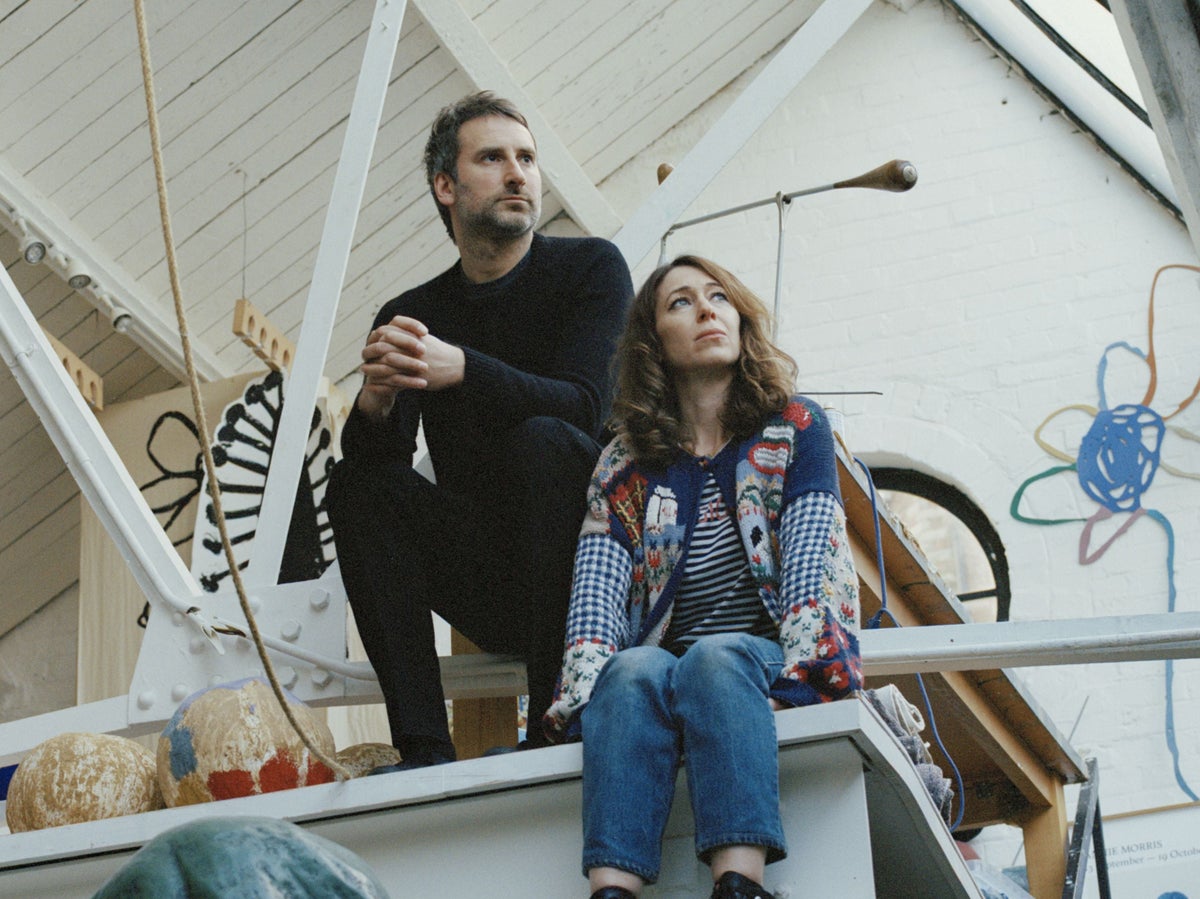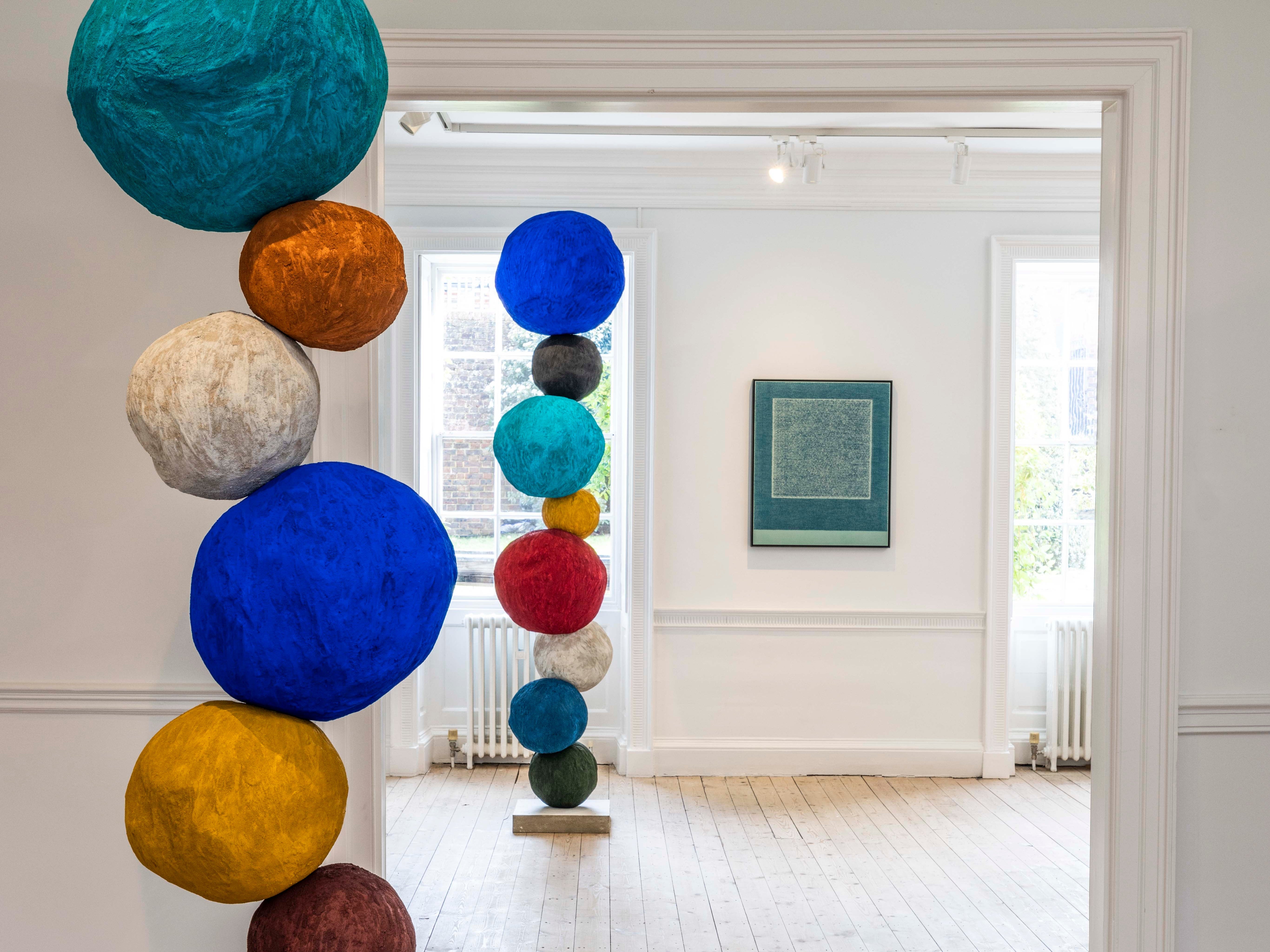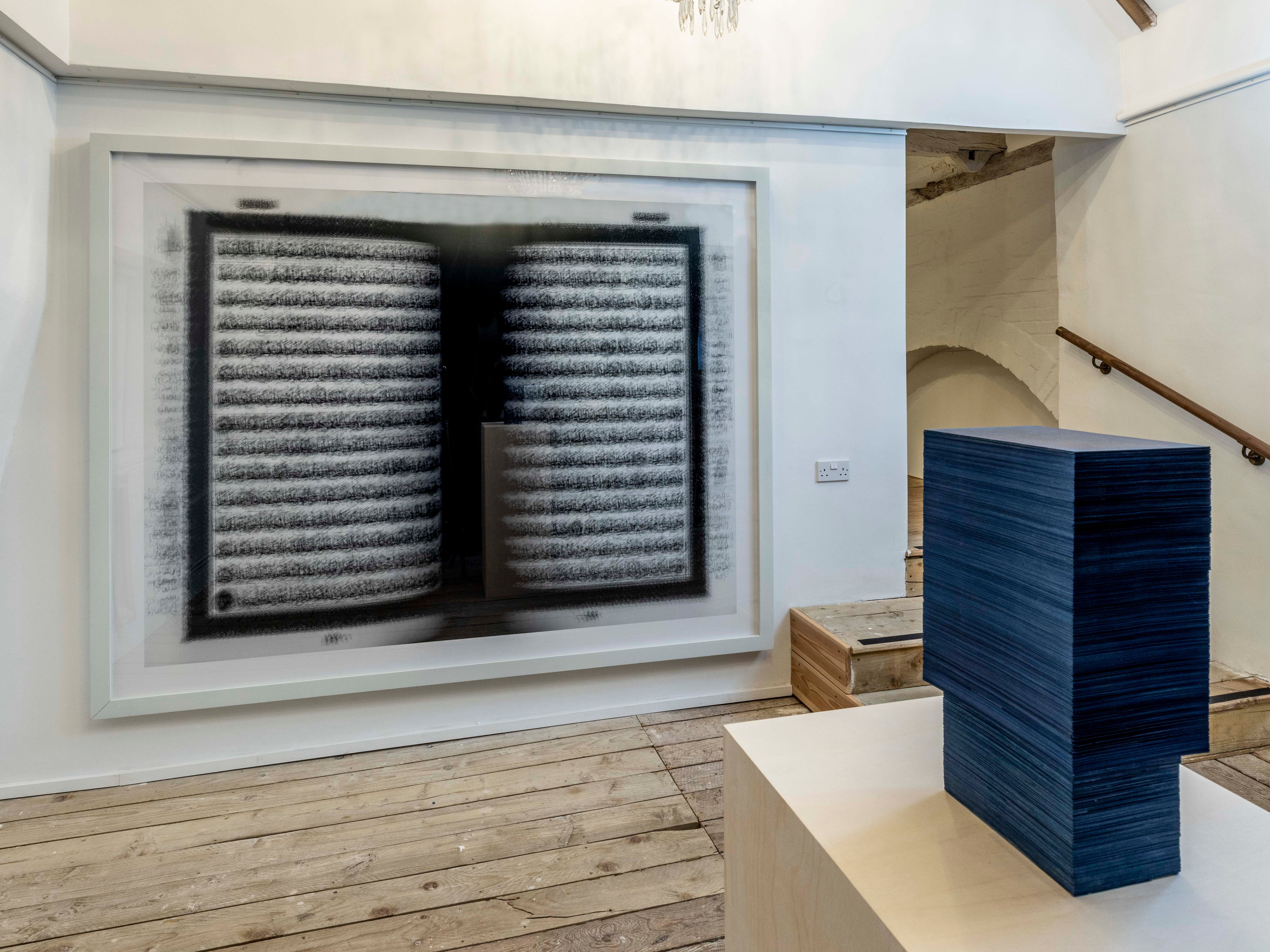
An artist should avoid falling in love with another artist – at least according to Marina Abramović, who in the 1970s gave us her great manifesto for life and art. “We have that quote on our stairs,” says Idris Khan, smiling, when I catch up with him and his wife, Annie Morris, after a walk-through of their absorbing new exhibition at Newlands House in Petworth, West Sussex. “We should have included it in the show,” she adds. He makes haunting composite images of words and music. She makes rainbow totems and tapestries. This is the first time they’ve officially collaborated.
We’re in a pub down the road, the couple sitting side by side across the table from me, visibly relieved that the prep is over and excited for the opening. Throughout our conversation, they bounce off one another, overlapping, reminiscing, gently teasing. The artists – who met in 2007, moved in together after a month, were engaged after five and have, they say, spent 24 hours a day with each other ever since – have flagrantly broken Abramović’s rule. (They’d probably call it guidance.)
Artists have been entangled for as long as they’ve been making art. There’s Dorothea Tanning, who married Max Ernst in a double wedding with Man Ray and the dancer Juliet Browner (who in a previous life dated Willem de Kooning, whose own creative partnership with Elaine was made messy by alcoholism and affairs). Frida Kahlo’s incendiary marriage to Diego Rivera was at once fruitful and destructive. Auguste Rodin worked side by side with his lover Camille Claudel for 10 years and claimed that desire was “a formidable stimulant”, though their relationship ended in part because she was tired of being referred to as his protege (also, he never made good on his promise to leave his wife).
What is it about artist couples that captures the imagination? The coming together of creative souls, perhaps? The promise of rivalry? The idea of passionate debates while toothbrushing? Whatever it is, there’s a market. At Newlands House, Morris and Khan follow quick on the heels of a show on Lee Miller’s relationship with Picasso. In March, an exhibition at Charleston will celebrate the work of George and Betty Woodman. Two of my favourite novels from last year reveal the sometimes harsh realities of such unions: in Lizzy Stewart’s Alison, a portraitist tells his student-turned-lover that thinking only about himself is what makes him “a great artist”; in Charlotte Mendelson’s The Exhibitionist, the sculptor protagonist spends her days sabotaging her own career because, according to her monstrous husband: “No couple can succeed in the same world.”
“Look, obviously sometimes it doesn’t work, but for us it does, and that comes from a generosity of spirit, I think – being open and generous and in unity,” says Khan. “I think it helps that we’re both doing very well at the moment, and that we’re able to make the work we want to make,” he adds, which hasn’t always been the case. While he was snapped up by Victoria Miro when he graduated from the Royal College of Art in 2004, Annie has, he says, “really built her career by herself”. Her best-known body of work – the Stack series, jaunty towers of irregular spheres coated in raw powdered pigments – began a decade later. “It shows there are different ways of coming to it,” she says, sharing the good news that one of her bronzes, a material she’d only ever dreamed of working with, has just been chosen to be permanently installed in Wakefield.
They have different energies – Morris fast and free-wheeling, Khan quiet and measured – which is apparent not just in their art but also in their ways of working. They share a studio in Stoke Newington, a former toy factory with six-metre-high ceilings. Their respective workspaces are adjoining – “There is a wall,” says Khan, faux relief in his eyes – and they often meet in the pigment cupboard, where he’s recently started helping himself to Morris’s dazzling blues and reds. “On my side, there’s a lot of chatting, the noise of a sewing machine, stuff everywhere, loud music,” says Morris. “Whereas it’s calm and meditative on Idris’s side. If he is playing music, it’s the opposite – I’ll have Steely Dan on while he’s listening to Vivaldi,” she laughs. “Passing from one to the other is like going from a storm into a sunny room.”

At Newlands House they each have an introductory room before, as the exhibition title suggests, the two worlds entwine. Composed of densely overlaid photographs, sheets of music and religious and personal texts, Khan’s carefully considered prints and sculptures hum with time and memory. Morris’s drawings and tapestries hover between figuration and abstraction and are instinctive and free. His palette is subdued, hers rich and luminous. His compositions are neat and orderly, hers sprawling and chancy. And yet, both are rooted in repetition. Words, treble clefs, a flower woman with a rounded belly, egg-like shapes, again and again.
“Artists are lucky to have something to turn to in tragic moments,” says Morris, as she describes the kind of creative outpouring that can come from grief. In 2010, Khan’s mother died, and the couple suffered a stillbirth. “I remember you would write, make rubber stamps from the text, push them into dark blue ink, for hours and hours at a time,” she tells her husband, who in turn recalls her making tight drawings in biro on vast sheets of paper, hiding herself in the pen marks and figures. Then she started to draw eggs. “After losing our first child, Annie was told she couldn’t have another,” says Khan. “For her, it was about trying to get back to that shape.”

Happily, the couple now have two children. During lockdown, the family left London and rented a barn near Petworth, on the South Downs. They found inspiration in the Sussex landscape – the hazy light and the lines in the fields – and at the heart of the exhibition are their responses to the changing seasons. Since then, they’ve bought a pair of workman’s cottages in the area, where they spend most weekends.
Islington is home, as it has been for the past decade. Although Two Worlds Entwined is their first joint exhibition, the houses they’ve shared have always been collaborative projects. “Of course, with two artists, there are lots of arguments about what goes where,” says Khan, eyes widening with an epiphany. “Oh my God, that’s another thing we should have included in the show – a shouty sound piece of us arguing, with the kids in the background. It’s all too domestic over there,” he explains, gesturing vaguely towards the gallery. “It’s all too nicey nicey.”
‘Two Worlds Entwined: Annie Morris and Idris Khan’ is at Newlands House until 7 May 2023







